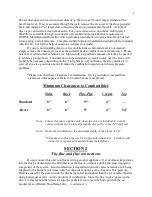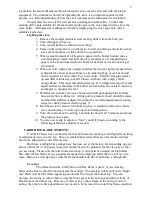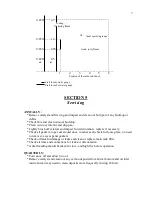
3. -Stove door not closed tightly.
-Low draft pressure/draft stabilizer not closing (check pressure).
-Carbon deposits at oil entry (operate de-coking rod).
-Cold flue.
-Plugged flue.
-Wind conditions causing pressure to be out of limits.
-Faulty catalyst.
4. -Any problems in (3) above.
-Dirt, carbon, or residue in burner bottom or fuel connection at burner (operate de-
coker).
-Low-fire set too low on carburetor (adjust, see section 4).
5. -Carburetor out of adjustment (decrease high-fire screw).
-Cold flue.
-Draft stabilizer needs adjusting (allowing too much air into flue).
-Flame set too high (flame impinging on baffle too much).
-Faulty gasket (door rope, glass seal, or relief plate seal).
-Excessive residue in burner bottom.
6. -High wind, or unstable draft condition.
-Incorrect carburetor setting (increase low-fire screw).
-Draft stabilizer out of adjustment.
-Faulty carburetor.
7. -Abnormally high, gusty winds (If you live in a windy area, a second draft stabilizer
may need to be installed in the pipe as well to compensate).
-A wind-directional cap or vacuum cap may be helpful to prevent wind gusts and
down drafts from affecting pressure.
8. -No oil in tank.
-Valve in fuel supply line shut inadvertently.
-Fuel supply blocked (plugged filter, frozen water).
-Carburetor on/off lever tripped.
9. -Stove door having been open for a while and then shut (a roaring noise can occur for
a short period until draft stabilizes).
-Draft stabilizer unable to open enough to compensate with the high draft condition.
(adjust high-fire setting, see section 4)
10. -Carbon deposits (operate de-coking rod).
-Draft stabilizer stuck closed.
-Draft pressure too high.
11. -Carburetor adjusted too high, allowing too much flame impingement on stove top.
-Flue plugged or dirty.
-Dirty burner or plugged fuel inlet (operate de-coker/clean burner bottom)
-House pressure problem
-Draft stabilizer out of adjustment.
-Faulty or deteriorated catalyst.
-Blocked or inhibited air supply to stove (check outside air supply to stove or room).
-Faulty gasket (door rope, glass seal, relief plate seal, or burner gasket).
9





























